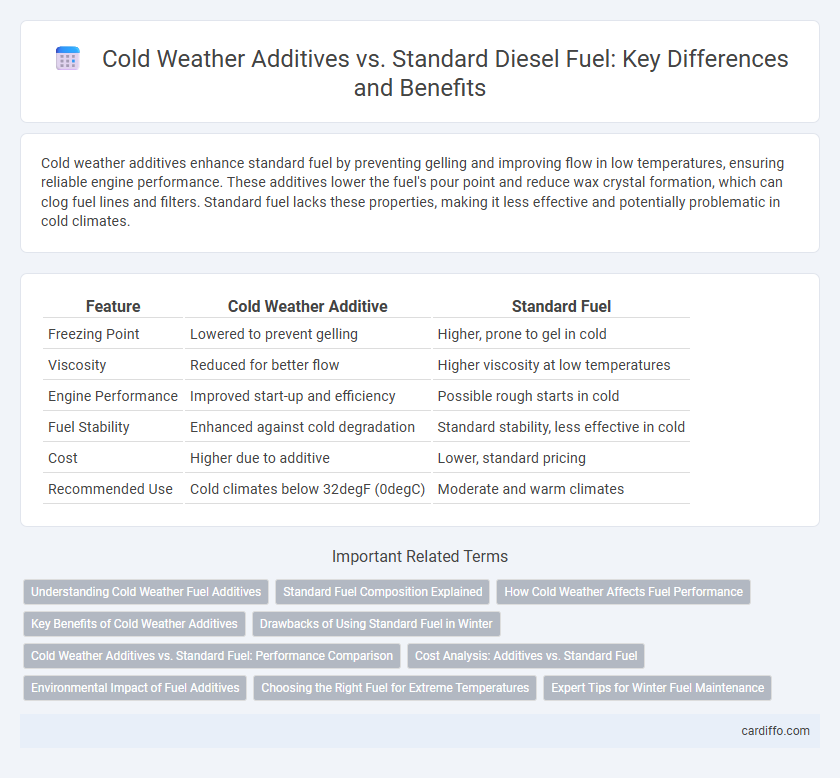Cold weather additives enhance standard fuel by preventing gelling and improving flow in low temperatures, ensuring reliable engine performance. These additives lower the fuel's pour point and reduce wax crystal formation, which can clog fuel lines and filters. Standard fuel lacks these properties, making it less effective and potentially problematic in cold climates.
Table of Comparison
| Feature | Cold Weather Additive | Standard Fuel |
|---|---|---|
| Freezing Point | Lowered to prevent gelling | Higher, prone to gel in cold |
| Viscosity | Reduced for better flow | Higher viscosity at low temperatures |
| Engine Performance | Improved start-up and efficiency | Possible rough starts in cold |
| Fuel Stability | Enhanced against cold degradation | Standard stability, less effective in cold |
| Cost | Higher due to additive | Lower, standard pricing |
| Recommended Use | Cold climates below 32degF (0degC) | Moderate and warm climates |
Understanding Cold Weather Fuel Additives
Cold weather fuel additives contain specialized anti-gel agents that prevent diesel and gasoline from thickening or crystallizing at low temperatures, ensuring consistent fuel flow and engine performance. These additives improve cold filter plugging point (CFPP), reducing the risk of clogged fuel lines and engine stalls in freezing conditions. Standard fuel lacks these modifications, making it susceptible to gelling and operational issues during extreme cold weather.
Standard Fuel Composition Explained
Standard fuel primarily consists of hydrocarbons derived from crude oil, including a mix of alkanes, cycloalkanes, and aromatic compounds tailored for optimal combustion efficiency. This composition ensures consistent energy output under normal temperature conditions but lacks the necessary properties to prevent gelling or waxing in cold weather. Unlike cold weather additives, standard fuel does not contain anti-gelling agents or cold flow improvers that lower the fuel's pour point and enhance fluidity at subzero temperatures.
How Cold Weather Affects Fuel Performance
Cold weather causes fuel to thicken, leading to reduced flow and impaired engine performance, which standard fuel struggles to withstand. Cold weather additives lower the pour point and prevent wax crystallization, ensuring smoother fuel flow and reliable combustion in freezing temperatures. Using cold weather additive-enhanced fuel improves engine start-up, reduces fuel filter clogging, and enhances overall fuel efficiency during extreme cold conditions.
Key Benefits of Cold Weather Additives
Cold weather additives significantly improve fuel performance by preventing gelling and waxing in low temperatures, ensuring reliable engine starts and consistent fuel flow. These additives enhance cold filter plugging point (CFPP) properties, reducing the risk of clogged filters and fuel lines during winter conditions. By maintaining fuel fluidity and combustion efficiency, cold weather additives extend engine life and improve operational reliability in harsh cold environments.
Drawbacks of Using Standard Fuel in Winter
Standard fuel in winter often leads to fuel gelling and clogged fuel lines due to its higher paraffin content and lower cold flow properties. This results in reduced engine performance, increased wear on fuel pumps, and potential stalling in extremely low temperatures. Cold weather additives improve fuel stability and prevent wax crystal formation, ensuring consistent combustion and reliable vehicle operation in freezing conditions.
Cold Weather Additives vs. Standard Fuel: Performance Comparison
Cold weather additives enhance fuel performance by preventing gelling and improving flow in subzero temperatures, ensuring engine reliability and efficient combustion. Standard fuel tends to thicken and may clog fuel filters or lines in cold conditions, leading to starting difficulties and increased engine wear. The use of cold weather additives results in smoother engine operation, reduced maintenance costs, and extended fuel system longevity during winter months.
Cost Analysis: Additives vs. Standard Fuel
Cold weather additives increase fuel costs by approximately 5-15% due to specialized chemicals that prevent gelling and improve flow at low temperatures. Standard fuel typically costs less upfront but risks engine damage and efficiency loss during cold conditions, potentially leading to higher maintenance expenses. Evaluating cold weather additive use involves balancing the initial additive price against long-term savings in fuel efficiency and engine reliability.
Environmental Impact of Fuel Additives
Cold weather additives in fuel improve flow and prevent gelling, reducing engine inefficiency and emissions during low temperatures. Standard fuel lacks these additives, leading to incomplete combustion and higher release of pollutants such as carbon monoxide and particulate matter. Environmentally, cold weather additives help lower greenhouse gas emissions by maintaining optimal engine performance and fuel efficiency in harsh climates.
Choosing the Right Fuel for Extreme Temperatures
Cold weather additives enhance fuel performance by lowering the pour point and preventing gelling in diesel, ensuring reliable engine start-up and operation in subzero temperatures. Standard fuel lacks these additives and is prone to waxing and clogging fuel filters when exposed to extreme cold, leading to engine power loss and potential damage. Selecting fuel with cold weather additives is crucial for maintaining optimal combustion efficiency and vehicle performance in harsh winter conditions.
Expert Tips for Winter Fuel Maintenance
Cold weather additives improve fuel performance by preventing wax crystals from forming and clogging filters, especially when temperatures drop below 20degF (-6degC). Experts recommend using additives containing anti-gel agents and dispersants to maintain fuel flow and engine efficiency during harsh winter conditions. Regularly inspecting fuel filters and storing fuel in insulated containers further enhances cold weather reliability and prevents costly maintenance.
Cold Weather Additive vs Standard Fuel Infographic

 cardiffo.com
cardiffo.com